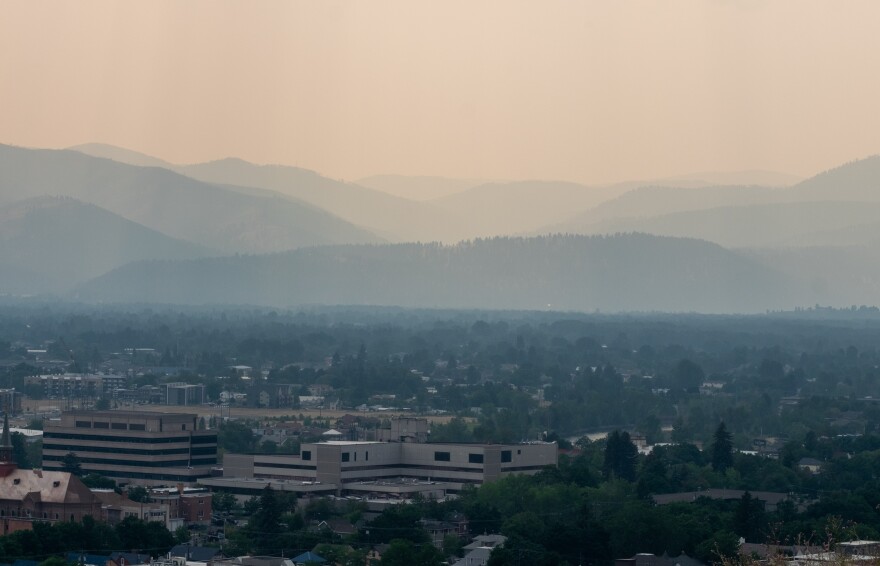Wildfire smoke is filling the sky across much of Montana. And as air quality reaches unhealthy levels, it's driving some people indoors. Some health officials worry COVID-19 cases could increase as unvaccinated people seek out public spaces like movie theaters and libraries to get a break from the hot, smokey weather.
Missoula just opened a brand-new public library, and people — including Grant Noblitt, Charlie Booher and Dave Juran — are flocking to it.
“We’re definitely trying to stay out of the smoke,” Booher says.
Missoula and other cities across Montana over the past week at times ranked in the top 10 locations across the country with the worst air quality, according toAir Now.
Despite Missoula County sporting the highest vaccination rate in the state at 60 percent, the COVID-19 pandemic is still on Whitney Kors’ mind as she takes her family to indoor spaces like the library to get out of the smoke.
“My daughter and I are still masked because she’s not vaccinated.”
Kors says that means her family will continue to distance themselves from others until her daughter becomes eligible for her shot.
This month, Missoula is seeing low case numbers and relatively small changes in how COVID is spreading. But that’s not the case in the Flathead Valley where 38 percent of residents are fully vaccinated
“We’ve seen a pretty significant uptick in cases,” says Health Officer Joe Russell.
Over the past couple of weeks, daily case numbers have spiked about 50 percent, Russell says. Flathead County has the most active COVID cases in the state, with about 180 cases.
Russell and his team are investigating how much of a role the heat and smoke are playing, but he says most new cases are coming from unvaccinated people attending events.
“These are activities that are happening specific to events or settings, and they are indoors.”
With a statewide vaccination rate of 48 percent, state health officials are keeping an eye on statewide case numbers and say heat and smoke pushing people indoors is also on their radar. For now, cases remain relatively low.
The science is clear that unmasked people gathering indoors drives infection rates up. But it’s very early to say exactly what wildfire smoke means in terms of COVID risk.
Daniel Kiser with the Desert Research Institute analyzed COVID test results in Reno, Nevada last summer, when a lot of smoke drifted into the area.
“And what we found was that there was about an 18 percent increase in the rate of positive tests during the period that was most affected by wildfire smoke,” Kiser says.
That’s only an association between smoke and a spike in positive COVID tests. Kiser’s research and other similar studies don’t provide a causal link. But the Centers for Disease Control and Prevention says the very tiny particles in wildfire smoke can lodge in the lungs, making people more susceptible to respiratory infections like COVID-19, especially as particles build up over time.
Other studies have also correlated increases in particulate levels with COVID-19 deaths. Sultan Ayoub Meo with King Saud University in Saudi Arabia was among a team of researchers that studied 10 California counties where fine particulate matter levels increased 220 times during the height of the state’s wildfire season last year.
“And here we found that the COVID-19 cases and deaths increased.”
Meo says cases increased by 57 percent and deaths by 148 percent among unvaccinated people. His team is now studying infection rates among partially and fully vaccinated people during wildfire smoke events.
University of Montana researcher Erin Landguth is also expanding her past study showing intense wildfire seasons in Montana have been followed by bad flu seasons months later in the fall and winter.
“Comparing bad fire seasons to non-bad fire seasons, one would expect to see three to five times worse flu seasons,” Landguth says.
She’s compiling particulate matter readings across the western U.S. to examine whether the same association holds across a larger area for not only the flu, but COVID and other respiratory diseases, too.
While evidence showing COVID cases and deaths have increased during wildfire events continues to emerge, more study is needed. But Landguth says, “Should we be worried about it? Absolutely.”
Back in Missoula, County Air Specialist Sarah Coefield says that’s why it’s all the more important to get vaccinated if you plan to seek out public spaces to escape excessive heat and smoke, or create a clean-air space at home.
“We know wildfire smoke messes with your immune system. We know that it increases your susceptibility to infectious disease. We know it leads to worse health outcomes if you have a disease.”
With about 2.5 million acres already burned across the country, Coefield is expecting a long, smokey wildfire season — and there’s nothing in the forecast to suggest it’s ending anytime soon.


